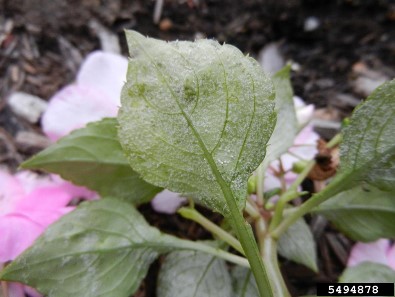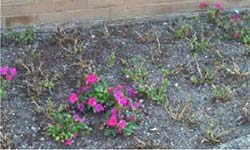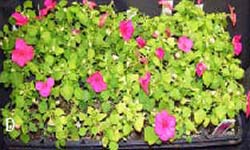Downy mildew of impatiens
Downy mildew of Impatiens species and cultivars was detected for the first time in Victoria, Australia in 2006. It was subsequently found in New South Wales and Queensland. The entry pathway of the Victorian detection is not known.
The disease is caused by the fungus-like Plasmopara obducens. It can cause:
- stunting, premature leaf fall
- poor flowering
- sometimes complete collapse and death.
Impatiens represent around 10 per cent of the bedding plant sector in Australia.
It has previously been found in North America, Asia and Europe.
Downy mildew symptoms
The first symptoms are usually pale green leaves. The underside of affected leaves may show a sparse or dense white layer covering the entire leaf surface (figure 1).

Affected leaves may appear mottled and then yellow and may fall prematurely (figure 2), or they may collapse. Plants can be stunted and produce small pale leaves with few or no flower production (figure 3).

Early symptoms of downy mildew infection may be difficult to detect as the characteristic white downy growth is restricted to the underside of leaves, and leaf symptoms may be confused with nutritional deficiencies or mite damage.

Spread of downy mildew
The disease is spread over short distances via water splash. It can be spread over long distances by spores dispersed in air currents, movement of infected asymptomatic cuttings, and possibly in seed.
Infected seed when sown, may produce systemically infected plants. Such plants may have a long latent period before symptoms are seen.
Managing downy mildew
Management should include:
- disease exclusion
- monitoring for disease symptoms
- hygiene
- cultural practices especially humidity control
- fungicide treatments.
Hosts
The host range apparently includes only cultivated and wild species of impatiens.
In Victoria the disease has been found in both single and double flowered commercial types.
Overseas records indicate that I. walleriana, I. balsamina and I. noli-tangere are hosts. There are also unconfirmed reports that New Guinea hybrids (Impatiens x hawkeri) are hosts.
Photo credits
Figure 1 – photo courtesy of Tom Creswell Purdue University
Reporting an unusual plant insect pest or disease
Report any unusual plant pest or disease immediately using our online reporting form or by calling the Exotic Plant Pest Hotline on 1800 084 881. Early reporting increases the chance of effective control and eradication.
Please take multiple good quality photos of the pests or damage to include in your report where possible, as this is essential for rapid pest and disease diagnosis and response.
Your report will be responded to by an experienced staff member, who may seek more information about the detection and explain next steps.
Report online